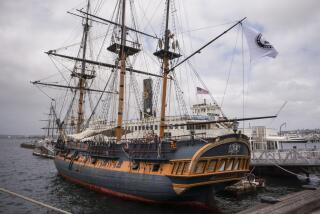Ahoy Mate! Nautical Language Isn’t Always Shipshape
- Share via
In a few days my wife and I will be leaving for a Caribbean cruise. As an ex-Marine, I am familiar with ships and their terminology; my wife, despite a few pleasure cruises, remains a landlubber.
I had wanted to cruise the Greek isles; the line we queried was very expensive, but its main drawback was that passengers do not have to pay for drinks, anything, any time of day. That sounded like too much of a good thing. Also, I dreaded those two long airplane rides.
Coincidentally, I have received a letter from Michael Cargal of La Mesa further elucidating the question of when a ship is a boat, and vice versa. As I concluded recently, a boat is any vessel that may be carried on a ship. While a ship may be called a boat in popular use (the Love Boat) that term is not accepted by sailors.
I’m sure our boat will be a ship.
A master mariner turned writer, Cargal includes a chapter on that subject from his new book. “My time at sea has been on vessels between 45 and 210 feet, from 15 to 500 tons. Without exception I called them all boats, and so did nearly all the other captains and all the owners but one.
“I ran a 56-foot passenger boat for a couple of summers out of Valdez, Alaska, carrying tourists out to look at glaciers. The owner called it a ship, but that was more advertising hype than a position on nautical semantics. . . .
“It should be enough that a ship is a big boat and a boat is a small ship. If you can live with that ambiguity, your life will be easier. Which word you use for a particular vessel will depend on how it feels to you, which may depend on whether you’re used to bigger or smaller.”
But sea-speak demands a distinction, he says, and he offers this one:
“The way I use the words, it’s a boat if the captain handles the engine and steering controls while docking it. If the captain directs operations from the wing of the bridge, while a seaman steers and the third mate relays messages to the engine room, it’s a ship. This means that a particular boat might be larger than a particular ship.”
When our vessel docks, you may be sure I will be out on deck, observing the procedure, so I’ll know whether it’s a boat or a ship.
Cargal has several ideas about nautical language, some of them heretical. He believes, for example, that a ship should be called it , not she , an idea he shares with feminists.
“Calling boats it is probably my biggest apostatic lapse from believing in the myth of the sea. A boat is a mechanical device, like a car or a garden tiller. To attribute to a boat the characteristics of a living being may be a permissible whimsy or romance, but it should not be required of those who feel differently about the sea, especially those who have passed enough water under the keel to earn the right to be unromantic.”
I have an idea that calling ships she dates from the old sailing days when ships sailed around the world disgorging their crews at ports in strange lands. Inevitably those sailors thought of the ship as their mother. She bore them, so to speak, and then took them back in after they had ravaged the town. It seems especially inescapable that the Queen Mary and the QE2 should be called she ; though it is not so suitable for the U.S. aircraft carrier Nimitz. Even so, I suspect that the Nimitz’s crew call her she.
Ex-sailors like me, whose affairs with ships have been fleeting and long ago, are the more punctilious is using sea language. I have an idea that no sooner will I board our ship than I will be going below or topside , and referring to the bathroom as the head, the floor as the deck, and our beds as bunks.
Cargal considers most sea talk unnecessary. “The reason that we have such a culture of sea-speak today is more complicated than where the words came from and involves the place of the sea in our mythology.
“It has nothing to do with reason. Indeed, it’s silly to care as much as some sailors do about preserving the purity of nautical language.”
He concedes that saying fore and aft instead of front and back makes some sense on a ship. Inboard and outboard may also be useful. “But most of the time it doesn’t matter.”
But one thing I try to remember: it’s OK to drink after the sun goes under the yardarm.
More to Read
Sign up for The Wild
We’ll help you find the best places to hike, bike and run, as well as the perfect silent spots for meditation and yoga.
You may occasionally receive promotional content from the Los Angeles Times.






